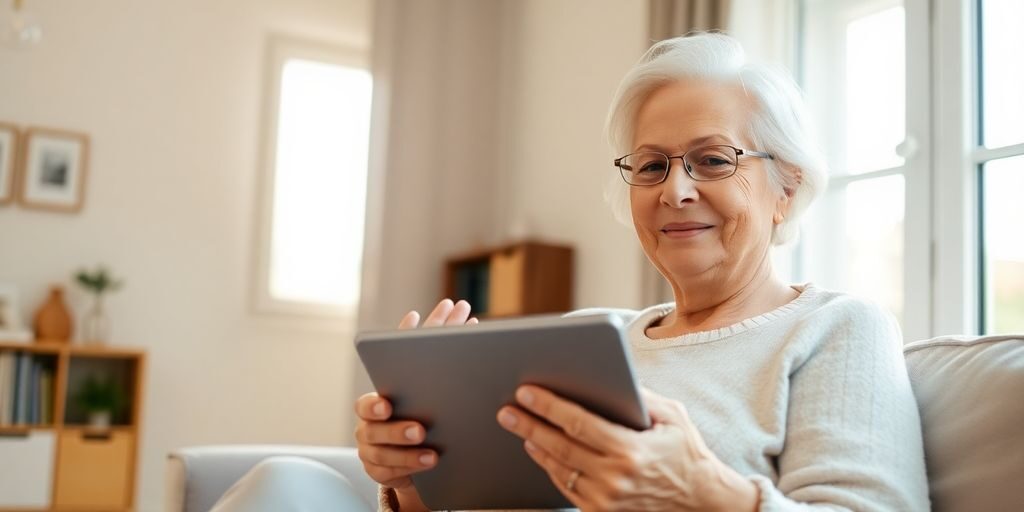Maintaining a Safe Environment for Elderly Individuals
It’s important to make sure the home is safe. This means looking at everything from lighting to flooring. Home safety is key to helping older adults stay independent.
Good lighting is a must. Make sure hallways and stairs are well-lit to prevent falls.
Consider nightlights in bedrooms and bathrooms. This helps with nighttime navigation.
Removing Tripping Hazards and Ensuring Accessibility
Tripping hazards are a big problem. Remove rugs or secure them with tape. Clear clutter from walkways.
Think about accessibility. Can your loved one easily move around the house?
Install grab bars in bathrooms. Ramps can help with stairs.
Regular Safety Assessments and Home Modifications
Regular checks are important. Walk through the house and look for potential problems. Home safety assessments can identify risks.
Make changes as needed. This might mean lowering shelves or installing a walk-in shower.
Home modifications can make a big difference. They can help older adults stay safe and comfortable in their own homes.
Benefits of Staying Home: The Case for Aging in Place
Staying at home as one gets older has a lot going for it. It’s about more than just comfort; it’s about keeping a sense of self and staying connected. Aging in place can really make a difference in someone’s life.
Enhancing Psychological and Emotional Well-being
Being in a familiar place can do wonders for the mind. It reduces stress and anxiety. Think about it: familiar smells, sounds, and memories all around. It’s a big comfort.
This comfort translates to better emotional health. People feel more secure and at ease in their own homes. It’s a simple thing, but it makes a huge difference.
Staying in a place you know well can help keep your spirits up. It’s about feeling safe and connected to your memories.
Fostering Independence and Autonomy
Aging in place lets people keep doing things on their own terms. They decide their schedule, their meals, and their activities. This control is super important.
It’s about maintaining a sense of self-reliance. Even small tasks, like making coffee or tending a garden, contribute to feeling capable and independent.
This independence boosts self-esteem. It’s a reminder that they’re still in charge of their lives. It’s a powerful thing.
Promoting Social Connections and Community Engagement
Staying in the same neighborhood means staying close to friends and familiar faces. These connections are vital for mental and emotional health. It’s about having a support system.
It’s easier to stay involved in local activities and groups. Whether it’s a book club, a church group, or just chatting with neighbors, these interactions keep people connected.
These social ties help prevent loneliness and isolation. It’s a reminder that they’re part of something bigger. Aging in place helps maintain these important bonds.
Leveraging Modern Medical Services for At-Home Care
The Rise of Medical House Calls
It’s not your grandma’s doctor visit anymore. Medical house calls are making a comeback, but with a modern twist. Think of it as healthcare delivered right to the doorstep, which is super convenient.
These aren’t just for emergencies. Doctors and nurses can handle routine check-ups, manage chronic conditions, and even draw blood, all in the comfort of home. This is especially helpful for folks who have a hard time getting around.
House calls reduce the stress of travel and waiting rooms. They also allow the medical team to see the patient’s living environment, which can provide important clues about their health.
Integrating Telehealth and Remote Monitoring
Telehealth is changing the game. It’s like having a doctor in your pocket, thanks to video calls and apps. This means quick consultations and advice without leaving the house.
Remote monitoring takes it a step further. Wearable devices and sensors can track vital signs like heart rate and blood pressure. This data is sent to healthcare providers, allowing them to spot potential problems early.
Here’s a quick look at the benefits:
- Reduced hospital visits
- Faster response to health changes
- Increased peace of mind for families
Personalized Care Plans and Early Detection
One-size-fits-all healthcare? No thanks. Personalized care plans are the way to go, especially for older adults. These plans are tailored to each person’s specific needs and health goals.
Early detection is key. Regular check-ups and screenings can catch problems before they become serious. This might involve blood tests, cognitive assessments, or even just a simple conversation about how someone is feeling.
Modern medical services are not just about treating illness; they’re about promoting wellness and independence. By combining house calls, telehealth, and personalized plans, we can help aging loved ones stay healthy and happy at home.
Empowering Aging Loved Ones Through Technology
Utilizing Smart Home Devices for Safety and Convenience
Smart home technology can really change things for older adults. It’s about making life easier and safer. Think about things like smart thermostats that keep the house at a comfortable temperature without them having to mess with it.
These devices can also help with safety. For example, smart lighting can turn on automatically at night, reducing the risk of falls. It’s all about creating a supportive environment.
Smart home devices offer a blend of safety and ease. They can monitor activity, send alerts if something seems off, and even help manage medications. It’s a way to keep an eye on loved ones without intruding on their independence.
Connecting with Family and Friends Through Digital Tools
Staying connected is super important. Technology offers ways for older adults to keep in touch with family and friends, no matter where they are. Video calls, social media, and email can help bridge the distance.
Digital tools can also help combat loneliness. Online groups and forums can connect older adults with others who share their interests. It’s a way to build community and stay engaged.
Teaching older adults how to use these tools is key. Simple tutorials and patient guidance can make a big difference. It’s about showing them how technology can enrich their lives.
Medical Alert Systems for Enhanced Security
Medical alert systems provide a safety net. These systems allow older adults to call for help in an emergency, even if they can’t reach a phone. It’s about providing peace of mind for both them and their families.
These systems can be especially helpful for those who live alone. They can provide a quick way to get assistance in case of a fall, medical issue, or other emergency. It’s a way to ensure they’re never truly alone.
Medical alert systems are evolving. Some now include features like fall detection and GPS tracking. This means help can be sent even if the person can’t speak or is unsure of their location.
Planning and Resources for Effective At-Home Elderly Care
Establishing a Comprehensive Support System
It’s important to build a strong support network. This includes family, friends, and professional care services. A good support system makes sure the elderly person feels cared for.
Having a team helps share responsibilities. It also provides emotional support for everyone involved. Don’t hesitate to ask for help; it’s a sign of strength, not weakness.
A strong support system is the foundation of successful at-home elderly care. It ensures that both the elderly individual and their caregivers have the resources they need to thrive.
Navigating Healthcare Management and Insurance Options
Healthcare can be confusing. Understanding insurance is key to managing costs.
Knowing what services are covered is important. Look into Medicare and Medicaid for help. This can ease financial stress.
Consider these points:
- Review all insurance benefits carefully.
- Understand coverage for home care costs.
- Explore options for necessary modifications.
Utilizing Community Resources and Support Groups
Community resources offer a lot of help. Local programs and meal services are available.
Support groups connect caregivers and seniors. These connections can reduce feelings of isolation. Planning ahead is key to finding the right resources.
Here are some examples of community resources:
- Senior centers
- Transportation services
- Adult day care programs
Caregiver Well-being: A Priority in At-Home Care
It’s easy to focus solely on the aging loved one, but caregiver well-being is just as important. If the caregiver isn’t healthy, both physically and mentally, they can’t provide the best care. Ignoring their needs leads to burnout and impacts the quality of care.
Caregivers often put their own needs last. This can lead to stress, exhaustion, and even health problems. Remember, taking care of yourself is not selfish; it’s necessary for providing good care.
Prioritizing the caregiver’s health is a win-win. A healthy caregiver can provide better care, and the aging loved one benefits from a more engaged and present caregiver.
Preventing Caregiver Burnout
Caregiver burnout is a real threat. It happens when the demands of caregiving outweigh the resources available. Recognizing the signs early is key to prevention.
Some signs of burnout include:
- Feeling constantly tired or overwhelmed
- Changes in sleep or appetite
- Increased irritability or anxiety
To prevent burnout, caregivers need to set realistic expectations. They should also learn to delegate tasks and ask for help when needed. Taking regular breaks is also important.
Seeking Support and Self-Care Strategies
It’s okay to ask for help. Caregivers don’t have to do it all alone. There are many resources available to provide support.
Support can come in many forms. It could be family members, friends, or professional caregivers. Support groups can also be a great source of emotional support and practical advice.
Self-care is also important. This means taking time for activities that the caregiver enjoys. It could be anything from reading a book to going for a walk. Caregiver well-being depends on it.
Balancing Caregiving Responsibilities with Personal Needs
Finding a balance between caregiving and personal life can be tough. It requires careful planning and prioritization.
One strategy is to create a schedule. This helps to allocate time for both caregiving tasks and personal activities. It’s also important to be flexible and adjust the schedule as needed.
Another strategy is to set boundaries. This means saying no to requests that are too demanding or that interfere with personal time. Remember, it’s okay to prioritize your own needs. This ensures long-term sustainability in caregiving.
Conclusion
Taking care of older family members at home can be a good thing for everyone. It lets them stay in a place they know, which helps them feel good and keep their independence. Using modern medical services, like telehealth and home health visits, makes this even easier. These services help manage health issues and keep things safe. It’s also important for family members who are doing the caring to get help themselves. Support groups and community programs can make a big difference. With some planning and the right tools, older adults can live well at home, surrounded by their loved ones and getting the care they need.





























